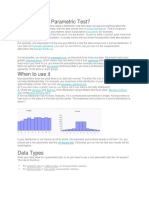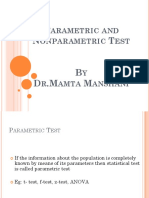Diff BT
Uploaded by
Karamveer SinghDiff BT
Uploaded by
Karamveer SinghExplanations > Social Research > Analysis > Parametric vs.
non-parametric tests
There are two types of test data and consequently different types of analysis. As the table
below shows, parametric data has an underlying normal distribution which allows for
more conclusions to be drawn as the shape can be mathematically described. Anything
else is non-parametric.
Parametric Non-parametric
Assumed distribution Normal Any
Assumed variance Homogeneous Any
Typical data Ratio or Interval Ordinal or Nominal
Data set relationships Independent Any
Usual central measure Mean Median
Can draw more Simplicity; Less
Benefits
conclusions affected by outliers
Tests
Choosing parametric Choosing a non-
Choosing
test parametric test
Correlation test Pearson Spearman
Independent measures, Independent-measures
Mann-Whitney test
2 groups t-test
Independent measures, One-way, independent-
Kruskal-Wallis test
>2 groups measures ANOVA
Repeated measures, 2
Matched-pair t-test Wilcoxon test
conditions
Repeated measures, >2 One-way, repeated
Friedman's test
conditions measures ANOVA
As the table shows, there are different tests for parametric and non-parametric data.
You might also like
- Parametric and Nonparametric Test: By: Sai Prakash MBA Insurance Management Pondicherry UniversityNo ratings yetParametric and Nonparametric Test: By: Sai Prakash MBA Insurance Management Pondicherry University10 pages
- Parametric and Nonparametric Machine Learning AlgorithmsNo ratings yetParametric and Nonparametric Machine Learning Algorithms18 pages
- Parametric & Non-Parametric Test... (Stats) Part2100% (1)Parametric & Non-Parametric Test... (Stats) Part24 pages
- Parametric and Nonparametric Test: By: Sai Prakash MBA Insurance Management Pondicherry UniversityNo ratings yetParametric and Nonparametric Test: By: Sai Prakash MBA Insurance Management Pondicherry University10 pages
- Categorical and Discrete Data Non Parametric TestsNo ratings yetCategorical and Discrete Data Non Parametric Tests162 pages
- Parametric Statistic Nonparametric Statistic: AnswerNo ratings yetParametric Statistic Nonparametric Statistic: Answer2 pages
- Module 004 - Parametric and Non-ParametricNo ratings yetModule 004 - Parametric and Non-Parametric12 pages
- Parametric and Non-Parametric Statistical TestingNo ratings yetParametric and Non-Parametric Statistical Testing19 pages
- final Parametric and Non-Parametric TestNo ratings yetfinal Parametric and Non-Parametric Test118 pages
- An Overview of Parametric and NonParametric Tests With AnnoNo ratings yetAn Overview of Parametric and NonParametric Tests With Anno28 pages
- Key Differences Between Parametric and Nonparametric TestsNo ratings yetKey Differences Between Parametric and Nonparametric Tests2 pages
- A Handbook of Statistics and Quantitative Analysis for Educational LeadershipFrom EverandA Handbook of Statistics and Quantitative Analysis for Educational LeadershipNo ratings yet



























































